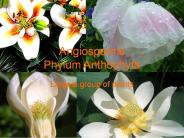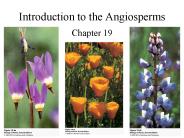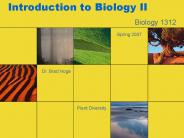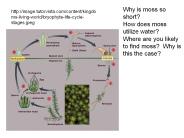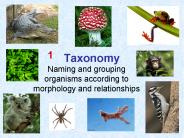Anthophyta PowerPoint PPT Presentations
All Time
Recommended
Angiosperms Phylum Anthophyta Largest group of plants Angiosperms are flowering plants. They have true roots, stems, leaves and flowers... Angiosperms are more highly ...
| PowerPoint PPT presentation | free to download
Anthophyta. Monocot vs. Dicot 'cot' = cotyledon (seed leaf) Monocots ... POEM will be 25% of the grade. 5 stanzas. 4 lines / stanza ...
| PowerPoint PPT presentation | free to download
Phylum Anthophyta The Flowering Plants Often called Angiosperms Characteristics of Phylum Anthophyta Seed enclosed in an ovary Mature ovary is called a fruit All have ...
| PowerPoint PPT presentation | free to download
EKU General Botany lab Flowering Plants Phylum Anthophyta or Magnoliophyta OVULE DEVELOPMENT Flowering plant ovary and ovules Flowering plant megasporangium and ...
| PowerPoint PPT presentation | free to download
Flowers come in many different styles and forms. As a result of pollination and ... Sepals (collectively the calyx) Petals (collectively the corolla) ...
| PowerPoint PPT presentation | free to view
Stamen (microsporophyll) with anther and filament ... Dicot seed with cotyledons, radicle, shoot axis, endosperm, and seed coat ...
| PowerPoint PPT presentation | free to view
Typical primary plant body. Leaf Venation. netted, pinnate. netted, palmate. parallel. Palmately Cmpd. Pinnately Cmpd. Bipinnately Cmpd. Aloe. Lithops. Lithops ...
| PowerPoint PPT presentation | free to view
Legume. Berry. Hesperidium. Pome. Pome. Pome. Drupes. Pepo. Pepo. Capsule. Samara. Samara. Nut. Aggregate-Accessory Fruit. Aggregate-Accessory Fruit. Multiple Fruit ...
| PowerPoint PPT presentation | free to view
nourish developing. spores) Pollen tubes. In both pictures below, note the ovary, and the ovules ... radioactivity exposed. the film, showing the. pathway of ...
| PowerPoint PPT presentation | free to view
Collect nutrients through their roots and exchange gases through their stomata. Reproduce sexually with the gametophyte ... Chocolate and Caffeine! Fun Facts ...
| PowerPoint PPT presentation | free to view
Anthophyta. Division Bryophyta 'Mosses,' 'liverworts,' 'hornworts' Moist terrestrial ... Division Anthophyta 'Flowering plants' Particularly successful in dry habitats ...
| PowerPoint PPT presentation | free to view
Systematics Kingdom Genus Species Family Order Class Phylum Plant Zea Z. mays Poaceae Poales Monocotyledonae Anthophyta Plant Vanilla V. planifolia Orchidaceae ...
| PowerPoint PPT presentation | free to view
Bryophyta- Non-vascular plants Dicranoweisia cirrata Tracheophyta- Vascular plants Pterophyta Coniferophyta Ginkgophyta Anthophyta Eudicots Monocots 1 2 3 4 5 Monocot ...
| PowerPoint PPT presentation | free to download
Angiosperm Reproduction and Biotechnology Chapter 38 Angiosperms Anthophyta More specialized xylem evolved. Tracheids seen in gymnosperms gave rise to vessel elements ...
| PowerPoint PPT presentation | free to view
Pines, firs, spruces, yews, junipers, cedars, cypress, and red woods. 550 species ... Cypress. Pine Farm. Phylum Anthophyta. Flowering Plants. Monocots and dicots ...
| PowerPoint PPT presentation | free to view
Anthophyta (flowering plants) 'bryophytes' seedless. vascular (L.V.P.s) plants. seed plants ... Generalized Bryophyte Life Cycle. Phylum Hepatophyta - the liverworts ...
| PowerPoint PPT presentation | free to view
Seed Plants cont. B. Angiosperms (seed container seed formed in an ovary) Division Anthophyta (flowering plants) Class Monocotyledones (monocots); one seed leaf ...
| PowerPoint PPT presentation | free to view
Chlorophyll a,b and carotenoids in chloroplasts. Starch stored inside chloroplasts ... B. Frith. M. Ayasse. Flowering plants. Anthophyta Characteristics ...
| PowerPoint PPT presentation | free to view
Introduction to the Angiosperms Chapter 19 Angiosperms- Anthophyta Autotrophic, but parasitic and saprophytic representatives. Enclosure of ovules within carpels.
| PowerPoint PPT presentation | free to download
... ginkgo Coniferophyta conifers Gnetophyta welwitschia etc. Anthophyta flowering plants heterospory The Plant Kingdom ... Sepals Present Phylogeny ...
| PowerPoint PPT presentation | free to download
Dicots By: Will Roller, Kevin Dick, Jonathan Finch Block 7 Basic Information Phylum- Anthophyta Geological Era- Mesozoic Existed during the late Triassic period Found ...
| PowerPoint PPT presentation | free to view
1. root system - functions to anchor the plant, absorb minerals & water, ... classes in Anthophyta; examples: roses, peas, buttercups,sunflowers, oaks, & maples ...
| PowerPoint PPT presentation | free to view
What is the function of a petal? Attract pollinators ... Peduncle. What division or phylum are the flowering plants in? Division Anthophyta ...
| PowerPoint PPT presentation | free to view
Phylum Anthophyta = flowering plants. Phylum Coniferophyta = conifers ... Reasons for Success of Flowering Plants. Fruits, adaptations for seed dispersal ...
| PowerPoint PPT presentation | free to view
A seed is a plant embryo having a supply of food and a ... Cross-section through an anther. various anthophyte pollens. vector-driven cross-pollination ...
| PowerPoint PPT presentation | free to view
... Ephydra exhibits double fertilization (most closely related to flowering plants) ... K. Division Anthophyta (flowering plants) - most diverse & widespread of the ...
| PowerPoint PPT presentation | free to view
Title: Kingdom PLANTAE Author: Peggy Jo Stanley Last modified by: Peggy Jo Stanley Created Date: 8/25/2002 11:42:29 PM Document presentation format
| PowerPoint PPT presentation | free to view
... and the vascular seed plants (5 phyla) Describe the basic plant life cycle and details of the ... Gymnosperms & Angiosperms Gymnosperm Life Cycle ...
| PowerPoint PPT presentation | free to download
Divisions of Seed Plants
| PowerPoint PPT presentation | free to view
Angiosperms. Adaptations to Land. Apical Meristems. Reproduction (Alternation of Generations) ... Plant. The Flower. Angiosperm Life Cycle. Pollination. Fruit ...
| PowerPoint PPT presentation | free to download
What is a Plant? with Plant Diversity Chapter 21 & 22 What is a plant? Multicellular eukaryote Produce their own food through photosynthesis Have thick cell walls ...
| PowerPoint PPT presentation | free to view
Multicellular Algae: The Seaweeds and Marine Plants I. Multicellular Algae Marine Algae = seaweed = macrophytes Classified in either Plantae or Protista depending on ...
| PowerPoint PPT presentation | free to download
Division Phaeophyta (Brown Algae): with fucoxanthin; ... What are the Different Types of Seaweeds, and How Do They Impact Our Lives? Author: Bill Last modified by:
| PowerPoint PPT presentation | free to view
KEY CONCEPT Plants can be classified into nine phyla. Mosses and their relatives are seedless nonvascular plants. Nonvascular plants grow close to the ground to ...
| PowerPoint PPT presentation | free to download
Lecture Ch. 30 _____ Chapter 30 ~ Plant Diversity II: The Evolution of Seed Plants Seed Plant Reproductive Adaptations Reduction of the gametophyte: shift from ...
| PowerPoint PPT presentation | free to download
Title: PowerPoint Presentation Last modified by: vhsetup.user Created Date: 1/1/1601 12:00:00 AM Document presentation format: On-screen Show (4:3)
| PowerPoint PPT presentation | free to download
Common name: Flowering plants, angiosperms. Synonyms: Magnoliophyta ... Strobili: Flower: pollen and seeds often formed in the same structure; ovules ...
| PowerPoint PPT presentation | free to view
Title: PowerPoint Presentation Last modified by: SAM13633 Created Date: 1/1/1601 12:00:00 AM Document presentation format: On-screen Show (4:3) Other titles
| PowerPoint PPT presentation | free to download
Seed Plants BSC 2011L Seed Vascular Plants Among plants, these include the gymnosperms and angiosperms Reproductive differences in seedless vs. seed plants Sporangia ...
| PowerPoint PPT presentation | free to download
Biological Classification * Why classify? Humans have developed classification systems in order to make sense of the abundant biological diversity that exists in nature.
| PowerPoint PPT presentation | free to view
... Carolus Linnaeus Classification Taxa of Domestic Dog -an example- Classification Hierarchy Binomial Nomenclature Other scientific names: Why scientific names?
| PowerPoint PPT presentation | free to download
TINGKATAN TAKSON DALAM KLASIFIKASI SPESIES ATAU JENIS Merupakan tingkatan takson yang terendah Makhluk hidup digolongkan dalam satu spesies jika secara alami dapat ...
| PowerPoint PPT presentation | free to download
Seed Plants BSC 2011L Seed Vascular Plants Among plants, these include the gymnosperms and angiosperms Reproductive differences in seedless vs. seed plants Sporangia ...
| PowerPoint PPT presentation | free to download
Title: Biology 5/15/07 Objectives: To learn about taxonomy. Class Topics Hand in Shark Key W.S. before the bell rings Chapter 16 exam review
| PowerPoint PPT presentation | free to download
Modification to process: a ovule is formed that becomes the seed. ... slender branch, ovule plants to Carboniferous plants that look like tree ferns. ...
| PowerPoint PPT presentation | free to view
Classification III: Kingdom Plantae AP Biology
| PowerPoint PPT presentation | free to view
Plant Diversity II Level 1 Biological Diversity Jim Provan Campbell: Chapter 30 Reproductive adaptations of seed plants Three life cycle modifications led to the ...
| PowerPoint PPT presentation | free to download
Defining Life (1) How do you know if something is alive? What are properties of living things that non-livings things do no possess? What is the smallest living thing ...
| PowerPoint PPT presentation | free to download
Title: No Slide Title Author: Chris Madison Last modified by: The Westminster Schools Created Date: 7/6/2000 8:22:46 PM Document presentation format
| PowerPoint PPT presentation | free to view
His ideas on classification have influenced generations of biologists during and ... reproduce from spores, and vegatatively by extension of the rhizome underground. ...
| PowerPoint PPT presentation | free to view
Chloroplasts contain Chloro-phylls a and b. Nonvascular plants. No vascular tissue ... Most have true roots and leaves. Require water for sexual reproduction ...
| PowerPoint PPT presentation | free to view
Carboniferous origin. Sporophyte dominant. Fern life-cycle. homospory. Crozier or fiddlehead ... 2 types of sporangia means 2 types of spores. Generalized Life ...
| PowerPoint PPT presentation | free to view
5 KINGDOMS ANIMAL PLANT FUNGI PROTIST MONERA Animal heterotrophic, multicellular organisms with organs or tissues. All have a larval or embryonic stage of development.
| PowerPoint PPT presentation | free to download
Cycads in South African park. Cycads are dioecious: this female plant has ovulate scales ... Cycad leaf leaflets unfurling like fern fronds (circinate vernation) ...
| PowerPoint PPT presentation | free to view
Sexual Life cycles Plant structure and Phylogeny The Angiosperms Outline Brief review 9. ALTERNATION OF GENERATIONS 8. PLANT EVOLUTION 7. ANGIOSPERM LIFE HIST.
| PowerPoint PPT presentation | free to view

